
About UsThe Numismatic Bibliomania Society is a non-profit organization promoting numismatic literature. For more information please see our web site at coinbooks.org SubscriptionsThose wishing to become new E-Sylum subscribers (or wishing to Unsubscribe) can go to the following web page link MembershipThere is a membership application available on the web site Membership Application To join, print the application and return it with your check to the address printed on the application. Membership is only $20 to addresses in the U.S., $25 for First Class mail, and $30 elsewhere. For those without web access, write to: David M. Sundman, Treasurer
AsylumFor Asylum mailing address changes and other membership questions, contact David at this email address: dsundman@LittletonCoin.com SubmissionsTo submit items for publication in The E-Sylum, just Reply to this message, or write to the Editor at this address: whomren@gmail.com BUY THE BOOK BEFORE THE COIN |
- WAYNE'S WORDS: THE E-SYLUM APRIL 13, 2014
- NEW BOOK: GUIDE BOOK OF U.S. COINS 68TH EDITION
- NEW BOOK: THE DOLLAR OF 1804
- NEW BOOK: XXI CENTURY COINS OF NEPAL
- BOOK REVIEW: CONFEDERATE FINANCE
- REVIEW: JOURNAL OF NUMISMATIC RESEARCH 3-5
- ANS RECEIVES GRANT TO FUND ONLINE ROMAN COINS PROJECT
- EVERETT JONES, 1933 - 2014
- NEIL TODD, 1936 - 2014
- NOTES FROM E-SYLUM READERS: APRIL 13, 2014
- 2014 MEMPHIS PAPER MONEY SHOW SPEAKERS
- MAJOR PRINCE AND THE 1859-S ONE DOLLAR GOLD PIECES
- A MODERN "GOOD FOR" TOKEN FROM SHEPHERDSTOWN, WV
- HARVEY STACK ON NUMISMATIC PEDIGREES
- MORE ON HUGO GRECO
- ASSISTANCE SOUGHT FOR 2ND EDITION OF VIRGINIA TOKENS
- THOUGHTS ON THE 1933 DOUBLE EAGLE CASE
- WAYNE'S NUMISMATIC DIARY: APRIL 13, 2014
- THE DIE THAT STRUCK BRITAIN’S FIRST COINS?
- ALAN WEINBERG ON DAVIS FLIGHT MEDALS
- THE COINS OF NEW YORK'S BRYANT PARK FOUNTAIN
- NUMISMATIC VOCABULARY: TERMINUS POST QUEM
- BAVARIAN RAINBOW CUPS: RARE CELTIC GOLD STATERS
- BASEBALL COIN DESIGNER CASSIE MCFARLAND
- SILVER EAGLE REVERSE DESIGNS DISCUSSED
- SOME RECENT COIN DESIGNS: APRIL 13, 2014
- MORTON & EDEN TO SELL RARE RUSSIAN COINS
- CONSERVATION OF THE BEAU STREET COIN HOARD
- HARVARD BOOK NOT BOUND IN HUMAN SKIN AFTER ALL
- PAUL BOSCO ON MANHOLE COVERS AND NUMISMATICS
- FEATURED WEB PAGE: ENGLISH BANKING HISTORY
Click here to access the complete archive
To comment or submit articles, reply to whomren@gmail.com
WAYNE'S WORDS: THE E-SYLUM APRIL 13, 2014

Our new subscribers this week include Diana Plattner, Eric Redell and Scott Alker. Welcome aboard! We have 1,719 email subscribers.
This week we open with three new numismatic books, two reviews, and word of the loss of two more fellow numismatists. Other topics include additional photos of Hugo Greco, Memphis Paper Money Show speakers, numismatic pedigrees, and the primary source of the 1859-S gold dollar.
To learn more about the new 1804 dollar book, Confederate finance, where fakes outnumber originals, Civil War cardboard scrip, Bavarian rainbow cups, anthropodermic bibliopegy and terminus post quem, read on. Have a great week, everyone!
Wayne Homren
Editor, The E-Sylum
NEW BOOK: GUIDE BOOK OF U.S. COINS 68TH EDITION
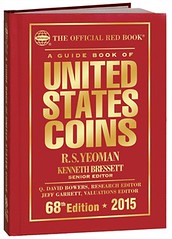 68th-Edition OFFICIAL RED BOOK™
68th-Edition OFFICIAL RED BOOK™
Debuts With Baseball Hall of Fame Coins
The newest edition of the Guide Book of United States Coins (known to hobbyists as the "Red Book") debuted at the Whitman Coin and Collectibles Expo on March 27, 2014. The 68th edition, with a 2015 cover date, can now be ordered online (including at Whitman.com) and is available in bookstores and hobby shops nationwide.
The Red Book, used by collectors to identify and value their coins, prices 7,600 entries in up to nine grades each, with more than 32,500 valuations in total. Keeping up with the latest coins from the U.S. Mint, the 68th edition has added pages in the "Quarter Dollars," "Silver and Related Dollars," "Modern Commemoratives," and "Gold Bullion" sections.
All of the Mint’s circulating coins have been updated with the most recent data. The 68th edition includes 92 new coin issues and 13 new sets, with information about the San Francisco Mint "America the Beautiful" quarters (the only circulation-strike quarters made in San Francisco since 1954), and new research on die varieties.
The Red Book debuted at the Whitman Expo along with the U.S. Mint’s latest commemorative coins: the National Baseball Hall of Fame half dollar, silver dollar, and $5 gold piece. The coins are featured in the book’s Commemoratives chapter. The cover of the 68th edition shows three classic American coins: the Buffalo nickel, the Saint-Gaudens $20 gold double eagle, and the Kennedy half dollar. The latter coin marks its 50th year of mintage in 2014.
Longtime Red Book contributors Donald H. Kagin and David McCarthy, who work on the book’s "Colonial Issues" and "Private and Territorial Gold" chapters, among others, were at the Whitman Expo. They exhibited portions of the famous $10 million Saddle Ridge Hoard of 1,427 gold coins recently discovered buried in eight metal cans in California.
As in past years, collectors will benefit from the Red Book’s recent auction records provided for significant rare coins. Listed throughout the charts are more than 170 notable auction results. Combined with the listed retail prices, the auction data help advanced collectors understand the modern market for high-end rarities.
In addition, the appendix of the "Top 250 U.S. Coin Prices Realized at Auction" has been fully updated. Since the last edition 13 more coins have broken the $1 million mark, for a new total of 65. This includes five new coins that sold for more than $2 million apiece since the 67th-edition Red Book debuted one year ago.
In a promising measure of the health of the hobby, the Red Book’s numismatic bibliography includes 22 standard references published within the past five years.
About the Guide Book of United States Coins
A Guide Book of United States Coins is the world’s most popular annual retail price guide for U.S. coins, tokens, and other numismatic items. More than 23 million copies have been purchased since 1946, making it one of the best-selling nonfiction titles in the history of U.S. publishing.
For the 68th edition, more than 140 professional coin dealers, scholars, and other numismatic experts contributed their knowledge under the direction of Senior Editor Kenneth Bressett, Valuations Editor Jeff Garrett, and Research Editor Q. David Bowers.
The 68th edition of the Red Book is available online and at bookstores and hobby shops nationwide. In addition to offering a Large Print Edition and several formats of the regular edition (hardcover; spiralbound softcover; and spiralbound hardcover), Whitman Publishing is also taking pre-orders for the leather-bound Limited Edition (500 copies autographed by Bressett). For more information and to order, the Whitman web site is www.Whitman.com.
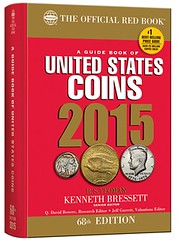 A Guide Book of
United States Coins, 68th edition
A Guide Book of
United States Coins, 68th edition
448 pages
Full color
By R.S. Yeoman; senior editor Kenneth Bressett; research editor
Q. David Bowers; valuations editor Jeff Garrett
$14.95 spiralbound
$16.95 hardcover
$19.95 spiralbound hardcover
$29.95 Large Print Edition
$69.95 leather-bound Limited Edition (500 copies)
NEW BOOK: THE DOLLAR OF 1804
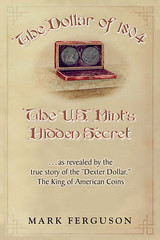 New discoveries about the famed 1804
Dollar will be announced at 6:00 pm on Thursday, April 24th at
the Central States Numismatic Society convention by professional
numismatist and researcher Mark Ferguson during a presentation
for the release of his new book, The Dollar of 1804 – The U.S.
Mint’s Hidden Secret. Ferguson will dispel age-old myths
about the 1804 Dollar, "The King of American Coins," by
exhibiting new evidence from the 1880s and earlier, some
signed.
New discoveries about the famed 1804
Dollar will be announced at 6:00 pm on Thursday, April 24th at
the Central States Numismatic Society convention by professional
numismatist and researcher Mark Ferguson during a presentation
for the release of his new book, The Dollar of 1804 – The U.S.
Mint’s Hidden Secret. Ferguson will dispel age-old myths
about the 1804 Dollar, "The King of American Coins," by
exhibiting new evidence from the 1880s and earlier, some
signed.
Based on the chronicles of the true story of the Dexter 1804 Dollar, The Dollar of 1804 – The U.S. Mint’s Hidden Secret, reveals newly discovered facts, not only about the Dexter Dollar, but about other 1804 Dollars as well. Ferguson’s research quest began in 1989 with his discovery and acquisition of a work of art, circa 1887, commissioned by James Vila Dexter himself in commemoration of the 1804 Dollar he purchased in 1885 for a record price at that time. A century later, in 1989, the Dexter Dollar set another world record as the very first coin to sell at public auction for the $1 million dollar level - $990,000.
Ferguson published limited edition prints of J. V. Dexter’s 1887 artwork, and in conjunction with SilverTowne and NGC has produced silver replicas of the 1804 Dollar encapsulated by NGC. The book release presentation will take place at the Central States Numismatic Society convention at 6:00 pm on Thursday, April 24th in room "Nirvana C." A question and answer session and book signing will follow Ferguson’s presentation.
Those in attendance who register will be entered into a drawing for a package consisting of a limited edition print of James V. Dexter’s 1887 work of art, an autographed copy of the new book, The Dollar of 1804 – The U.S. Mint’s Hidden Secret, an 1804 Dollar silver replica encapsulated by NGC, and other bonuses all valued at $495.00. Interested persons who are unable to attend may register online at www.1804Dollar.com for a drawing of an autographed book and an NGC encapsulated replica of the 1804 Dollar valued at $99.00. Ferguson will also be signing books at the CSNS book signing table at noon on Friday and Saturday.
Mark adds:
I will only have a soft cover edition available at Central States. The retail price is $29.95. I plan on publishing a hard cover edition with extra content that will only be available with the limited edition print package of James V. Dexter’s 1887 artwork and the 1804 Dollar silver replica and possibly a couple of other bonuses. People can contact me to purchase at: mark@1804Dollar.com or at 920-233-6777. More info will be posted at www.1804Dollar.com.

NEW BOOK: XXI CENTURY COINS OF NEPAL
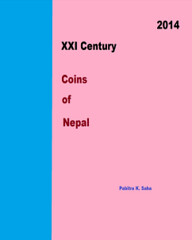 Nepal, a land locked country
in South Asia, boasts of Himalayas, the highest mountain range in
the world. In addition, it has a rich legacy of nearly 4,000 year
history of having never been conquered or rules by foreign
powers.
Nepal, a land locked country
in South Asia, boasts of Himalayas, the highest mountain range in
the world. In addition, it has a rich legacy of nearly 4,000 year
history of having never been conquered or rules by foreign
powers.
It is the coins of this country, which became a democracy as late as 2007, that form the subject of this monograph.
For more information, or to purchase, see: XXI
Century Coins of Nepal
(play.google.com/store/books/details?id=Lj8-AwAAQBAJ)
BOOK REVIEW: CONFEDERATE FINANCE
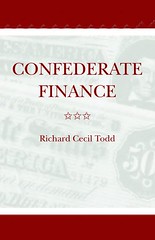 I was Googling the other day (always
dangerous for me) and I found two nice 19th century articles on
the final fate of the Confederate Treasury in Georgia in
1865.
I was Googling the other day (always
dangerous for me) and I found two nice 19th century articles on
the final fate of the Confederate Treasury in Georgia in
1865.
(In light of the article in last week's E-Sylum on "Davis Flight Medals," let me say that the first is "The Last Days of the Confederate Treasury and What Became of the Specie" by M. H. Clark, who was the last Acting Treasurer of the CSA. His article appeared in the Southern Historical Society Papers in 1881 and is available via Google Books.
The second article is "The Story of the Virginia Banks Funds" by Otis Ashmore, which appeared in The Georgia Historical Quarterly in December 1918. It is also available via Google Books.
More interesting for my purposes, I also found Confederate Finance by Richard Cecil Todd (University of Georgia Press, 1954, reprinted 2009), which makes heavy use of the archives of the Confederate Treasury Department, which are now part of the National Archives. And, having been written by a history professor, it has lots and lots of end-notes and a great bibliography. The book provides an excellent summary of Confederate finances and includes chapters on the Treasury Department, Loans, Treasury Notes (Confederate currency), Tariffs and Taxes, Seizures and Donations and Financial Operations Abroad.
And, the best part about the book is that it's available as a PDF for free (from UGA, I believe): http://dlg.galileo.usg.edu/ugapressbks/pdfs/ugp9780820334547.pdf .
Now, as someone interested in the southern mints, this book is a great find!
As you may recall, Breen (in Walter Breen's Complete Encyclopedia of U.S. and Colonial Coins ) makes a couple of references to what happened to the southern mints' specie following secession (and also what happened to the specie in the Confederate Treasury), but he provided few details and no specific sources. Clair Birdsall, in The United States Branch Mint at Charlotte, North Carolina: Its History and Coinage , at least, quotes from letters to and from Confederate Treasury Secretary Memminger.
Interestingly, in his bibliography, Birdsall refers to Record Group 104 of the National Archives (which, as all us fans of Roger Burdette know, is where the Mint records are), but he doesn't refer to Record Group 56 (Archives of the Confederate Treasury Department), so I wonder if Birdsall relied only on RG 104 and not also RG 56.
Anyway, Confederate Finance provides some information that is "news to me" - details about what happened to the southern mints' specie, letters about the Confederate half dollar and cent, additional information about Confederate bonds and currency, etc., all with detailed footnotes and bibliography for further reading.
While I presume that this information is known to the Civil War historians and to the Confederate and southern states currency researchers and collectors, I'm not sure it has made its way to the coin collectors.
It's a useful reminder to a researcher to cast a wide net and look at topics from several viewpoints - one never knows what the "other guy" knows until one looks!
To read the Google books articles, see:
Southern Historical Society Papers, Volume 9
The Georgia Historical Quarterly 1918
To read the earlier E-Sylum article, see: MORE ON ENGRAVED CONFEDERATE DAVIS FLIGHT MEDALS (www.coinbooks.org/esylum_v17n15a21.html)
REVIEW: JOURNAL OF NUMISMATIC RESEARCH 3-5
In December I reviewed the Spring 2013 (Issue 2) of Roger Burdette's excellent periodical, the Journal of Numismatic Research. I've fallen woefully behind in my reviews of all books this year, so in an attempt to play catch-up I'll highlight the three new issues Roger has generated in the interim. It's a stretch to call these "reviews", but hopefully I can add some color to the distributor's description.
JNR Summer 2013, Issue 3
From the Wizard Coin Supply web site:
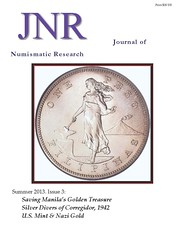
The Summer 2013 JNR is 62 pages devoted to valiant attempts by Filipino and American military and civilian personnel to prevent gold and silver from falling into the hands of the invading Japanese Army at the onset of World War II. This edition of the JNR includes the following three articles, all authored by Roger W. Burdette:
Saving Philippine Gold at the Beginning of World War II
January to March 1942
Following the surprise attack on Manila on December 8, 1942, banks and individuals sought to get their valuables, including gold bullion from local mines, to safety. One American submarine was able to help by using the gold and silver as ballast.
The successful voyage of the "golden ship" USS Trout from Corregidor Island to Honolulu with its ballast crammed with gold, received considerable publicity on the American Homefront. Several popular articles appeared during and after the war that outlined the general events but omitted, or altered many details for war-time consumption. The article in this JNR presents the best modern research on the background, execution and conclusion of this amazing event. Copes of declassified relevant War Patrol Reports are included.
Silver Divers of Corregidor
World War II: May to November 1942
After all the gold and some of the Philippine silver was smuggled out on the Trout a large quantity of silver coins remained. Just before the Philippine island of Corregidor fell to the Japanese, these silver coins were dumped in Manila Bay. It was hoped that the coins could thus be hidden from the invaders. The Japanese soon learned the location and conscripted American Navy divers to bring the money to the surface. This fascinating story of bravery and determination was unknown during the war and received little public attention afterward. It was not until one of the divers, Robert C. Sheats, published his private memento of captivity, One Man's War: Diving as a Guest of the Emperor, that the story gained much-deserved attention.
U.S.Mint & Nazi Gold, Merkers Kaiseroda Salt Mine
Treasure
World War II: June to August 1945
This brief bonus feature reveals the U.S. Mint's role in recovering Nazi looted treasure following VE Day. Under orders from Nazi leadership, primarily Herman Goering and Heinrich Himmler, conquered people and nations were systematically stripped of art, gold and other valuables. Recovery of the treasure after the end of the European war had an unexpected connection to the U.S. Mint.
I've already heard from other numismatists about how interesting and useful this issue is - never has so much information on the Philippine silver dump and recovery been compiled in one place. I'd read bits and pieces of the story in other publications, but this was a real page-turner, with interesting tidbits throughout.
The related tale of the recovery of the Nazis' looted gold is another great story, particularly in light of the recent release of the film Monuments Men. The photo of a room filled with thousands of bags of gold is priceless. Highly recommended for anyone who enjoys the sweep of history and how its ebbs and flows directly affect people and their coinage.
JNR Autumn 2013, Issue 4
From the Wizard Coin Supply web site:
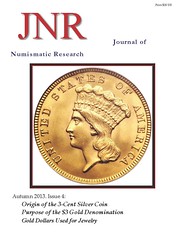
This issue of the Journal of Numismatic Research features four short articles written by Roger W. Burdette.
Origin of the 3-Cent Silver Coin --Beneath the angry public debates on slavery, new state admissions and regional commerce, two important topics permeated the country. One was the need for consistent national currency of gold and silver coins that was uniformly available and of equal value everywhere. The other was revision of the postal service so it could cheaply and securely ensure written communication across a vast, largely unpopulated continental nation. Out of these dual topics, emerged the nation's first 3-cent coin.
Next comes a one page opinion piece James B. Longacre as a Die Engraver.
Purpose of the $3 Gold Coin -- Coin collectors have long wondered why Congress approved introduction of a $3.00 gold coin in 1854. Numerous speculations have been put forward, but none identified the initial motivation for this odd, seemingly useless denomination. Learn the real reason for the $3 gold coin with this short article.
Gold Dollars Used For Jewelry -- Necklaces, bracelets, cufflinks, rings, pendants and a multitude of other items of personal adornment became the final resting places of thousands of tiny gold dollars. Coin collectors were the only refuge for these forgotten gold pieces.
This is an issue focused on two related "threes" - the three-cent silver coin and the three dollar gold piece. Roger reviews congressional legislation and contemporary news accounts to piece together the story of the origin of this tiny coin. Sen. Daniel Dickinson of New York introduced legislation in 1850 for new one and three cent coins to help replace fractional Spanish silver coins, which were still commonly used in circulation. In 1851 the adoption of the lower three-cent rate for postage also fueled the drive for the three-cent coin.
Meanwhile, Roger's research indicates that contrary to statements found elsewhere in hobby publications, Congress did not link these coins to the new postage rates. In fact, these "purposeless curiosities" existed more as jewelry items than commercial specie, as did the diminutive one-dollar gold piece.
The issue is rounded out by a short opinion piece which somewhat redeems James Longacre's reputation in other numismatic publications as an incompetent die sinker. While not exceptional, neither was Longacre a bumbling neophyte.
JNR Winter 2014, Issue 5
From the Wizard Coin Supply web site:
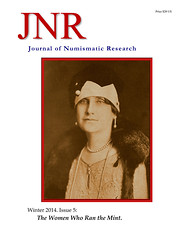
This issue of the Journal of Numismatic Research, Winter 2014, examines the roles and relationships of female managers in Mint Bureau operations. Women had worked at the Philadelphia Mint since 1850, but it was not until 1875 that the first woman with professional qualifications was hired. Another generation passed before a woman, Margaret Kelly, was assigned to management responsibilities. Over the next thirty years Kelly and then Mary O’Reilly gradually expanded the management responsibilities of women until the first female director, Nellie Tayloe Ross, was appointed by President Roosevelt in 1933.
Three interconnected articles reveal the social, technological and political changes that opened professional and managerial jobs to women, and explore forces that brought these three women into positions of authority over the nation’s coinage.
As much as I've enjoyed all issues of JNR, this one is my favorite to date. Weighing in at a beefy 58 pages, this issue goes into depth about the women who have served as directors of the U.S. Mint. Not generally a topic covered in the numismatic press, this issue opens a window into the personalities and lives of these three pioneers. Also covered is Director Nellie Tayloe Ross' personal secretary Edness Wilkins, a heretofore unknown who nevertheless played an important role at the Mint, and was the only active coin collector among the staff at the time, collecting commemorative halves and U.S. Mint medals and speaking at her local coin clubs.
All of the issues pass my back-of-the-book test, with extensive footnotes, endnotes and bibliographies. All are highly recommended.
For more information, or to order, see:
REVIEW: JOURNAL OF NUMISMATIC RESEARCH, SPRING 2013
(www.wizardcoinsupply.com/journal-of-numismatic-research/)
To read the earlier E-Sylum article, see REVIEW: JOURNAL OF NUMISMATIC RESEARCH, SPRING 2013 (www.coinbooks.org/esylum_v16n52a06.html)
ANS RECEIVES GRANT TO FUND ONLINE ROMAN COINS PROJECT
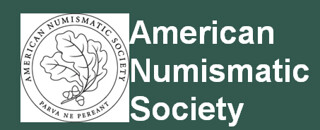 The American Numismatic Society (ANS) and
the Institute for the Study of the Ancient World (ISAW) are
delighted to announce the receipt of a major grant of $300,000
from the Division of Preservation and Access of the National
Endowment for the Humanities. The grant, made as part of the
Humanities Collections and Reference Resources program, will
provide for the full implementation of the Online Coins of the
Roman Empire (OCRE) project.
The American Numismatic Society (ANS) and
the Institute for the Study of the Ancient World (ISAW) are
delighted to announce the receipt of a major grant of $300,000
from the Division of Preservation and Access of the National
Endowment for the Humanities. The grant, made as part of the
Humanities Collections and Reference Resources program, will
provide for the full implementation of the Online Coins of the
Roman Empire (OCRE) project.
Co--directed by Dr. Andrew Meadows of the ANS and Professor Roger Bagnall of ISAW and managed by Dr. Gilles Bransbourg, OCRE is a ground--breaking initiative to create an online reference and cataloguing tool for coinage of the Roman Empire. Through its use of a Linked Open Data model, OCRE will provide full descriptions and illustrations of the 45,000 different types of Roman Imperial Coinage, as well as providing a union catalogue of specimens held in major collections. Currently the collections at the ANS in New York, the Bode Museum in Berlin and the University of Virginia Art Museum are included. It is hoped over the lifetime of the project to add the collections of the British Museum in London and the Bibliothèque nationale de France in Paris, as well as other collections as they become available online.
Within three years, OCRE will also begin to include coin find information from the UK’s Portable Antiquities Scheme and the European Coin Finds Network. OCRE will additionally provide tools to chart the distribution of coin types, and to analyze metrological, stylistic, and typological data on the basis of coins included in the union catalogue. The OCRE interface is currently fully searchable in eleven languages, rising to twenty over the course of the project.
To read the complete press release, see: The American Numismatic Society and the Institute for the Study of the Ancient World receive a major grant from the NEH (numismatics.org/wikiuploads/NewsEvents/2014_0404_PR_major-grant-NEH-.pdf)
THE BOOK BAZARRE
EVERETT JONES, 1933 - 2014
Colin Gullberg, editor of Chopmark News, the newsletter of the Chopmark Collectors Club writes:
Sadly CCC founding member and long-time Chopmark News editor Everett Jones has passed away. Everett is the single most important person in the CCC's existence, having founded the club in 1990 and started and edited the newsletter for a considerable length of time. Apart from Rose's Chopmarks, Everett's Chopmark News was the most important resource for the chopmarked collector. He will be missed.
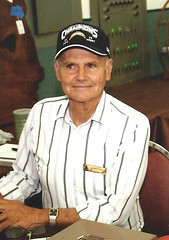 CG: What made you start to collect chopmarked coins?
CG: What made you start to collect chopmarked coins?
EJ: It was when I saw Rose’s exhibit at the ANA show in San Diego in the early 1980s. It was so fascinating and so different I just had to find out more about these coins. He had a beautiful exhibit and I had never seen anything like it before.
CG: Did you meet Frank Rose?
EJ: No, never. I wrote to him, this was before his book was out, and he replied that his book, Chopmarks, was going to be soon published. But that show was what started it all. But I did most of my collecting in the late 80s before too much infor-mation was out. Rose hadn’t even got his book out by then. So, I never met him but he did correspond with me.
EJ: Yes, it was a Bolivian 8 reales that a friend bought for me out of a junk box for $8. At that time that’s what they were, junk box coins.
CG: They aren’t $8 now.
EJ: No, at shows there just isn’t as much available now like it used to be.
CG: Why do you think that is?
EJ: I think they’re in collections, locked up.
CG: You started the newsletter before the internet existed.
EJ: Oh yeah. It was done on a typewriter. People today don’t even know what that is. I used my electric typewriter for the first few issues. I don’t know when eBay and the internet started but I’ve been on eBay for ten years.
CG: How did you get all your information when there was no internet?
EJ: Letters. I advertised in one of the coin papers and all the people that responded were the early members. I had a good response. The early group were quite responsive. Everything was done by mail. I did the layout and pictures myself.
For more information about the Chopmark Collectors Club, see: http://chopmarks.org
NEIL TODD, 1936-2014
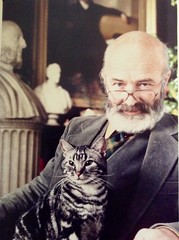 Todd, Neil Bowman of Newtonville, Massachusetts, passed away on
Sunday, March 30, 2014 after a lengthy illness. Neil was born on
January 3, 1936 in Cambridge, MA, the son of Albert Bradbury
Todd, Jr. and Mary Heath Todd. Neil’s love of traveling and world
affairs began when he was young, traveling and living with his
military family on Army Air Corps bases in Alabama, Maine and
Wales.
Todd, Neil Bowman of Newtonville, Massachusetts, passed away on
Sunday, March 30, 2014 after a lengthy illness. Neil was born on
January 3, 1936 in Cambridge, MA, the son of Albert Bradbury
Todd, Jr. and Mary Heath Todd. Neil’s love of traveling and world
affairs began when he was young, traveling and living with his
military family on Army Air Corps bases in Alabama, Maine and
Wales.
From the age of seven, Neil was an avid collector, specializing in comic books, coins and stamps. For many years, he was affiliated with numismatic societies and was a co-founder of Colony Coin Company in Newtonville with his partners Harvey Fenton, Charles Wallace and Arthur Fitts III.
Neil graduated from UMass/Amherst with Honors in Zoology for his publication on "The Inheritance of Taillessness in Manx Cats." While at UMass/Amherst, he met his wife, Joyce (Seat) Todd of Springfield, MA. Neil and Joyce moved to Newtonville when Neil began his doctoral studies in biology at Harvard University, completing his dissertation, The Catnip Response, in 1963. An N.I.H. post-doctoral fellowship and the Committee for the Study of Evolutionary Biology at Harvard University supported his field studies on the lions in the Gir Forest, Gujarat State, India. Dr. Todd was affiliated with and taught biology at Harvard University, Boston University, Lesley University, Emmanuel College and Trinity University in Dublin, Ireland.
He combined his love of history with his interest in genetics, engaging in extensive travel in order to map the gene frequency distribution of the domestic cat. By conducting historical research on shipping and trade routes, he was able to determine how specific coat patterns and other genetic markers were distributed throughout the world. His field studies were conducted in Canada, Great Britain, Ireland, Iceland, Faroe Islands, France, Spain, Iran, Morocco, Tunisia, Greece, Turkey, Egypt, Sudan, Mexico, Curacao, and Venezuela.
For seventeen years, Dr. Todd published The Carnivore Genetics Newsletter with Roy Robinson in charge of the editorial office in London. Dr. Todd’s articles have also appeared in the Journal of Heredity, The Cornell Veterinarian, Journal of The Bombay Natural History Society, Journal of Theoretical Biology, Current Anthropology, Paleobiology, Genetica, Proceedings of the Royal Irish Academy and Scientific American.
Throughout his life, Neil maintained an interest in numismatics, developing a special interest in 19th century tavern checks of the British Isles and Ireland. Together with his colleague Andrew Cunningham of Ruddington, Nottingham, U.K., Neil published numerous catalogues of tavern checks, a pursuit he continued until his death.
For the past twenty years, Neil was affiliated with the New England Historical Genealogical Society where he was head of Research Services in the 1990’s. He thoroughly enjoyed helping people learn about their ancestry. He was actively involved in The Taft Family Association both as a member and as Vice President & Genealogist until illness prevented him from participating. He had also been a member of the Bartlett Family Association for many years.
In the 1980’s, he interrupted his already busy life by buying and restoring a 1931 Worcester lunch car with Charles Wallace. They purchased the Midway Diner and moved it from Shrewsbury to Pleasant Street in Watertown where they spent several years restoring it.
Neil had an adventurous and unusual life until his health began to fail a few years ago due to auto immune disease and cigarette smoking. He remained interested and well-versed in history and world affairs until his death, enjoying animated discussions with his grandchildren.
He is survived by his wife of 54 years, Joyce (Seat) Todd, two daughters, Lydia of Peabody and Amy of Cambridge, son-in-law Robert Sousa, grandchildren Griffin, Todd, Jolie and Samuel, step-grandchildren Samantha and Emily, his close cousins in New Hampshire and North Carolina, and his sister-in-law, Judi (Seat) Neylon. He enjoyed the company of friends and colleagues around the world.
To read the complete online obituary, see: Obituary for Neil Todd (burkefamilyfuneralhomes.com/book-of-memories/1842939/Todd-Neil/obituary.php)
NOTES FROM E-SYLUM READERS: APRIL 13, 2014
SS Gairsoppa Bullion Coins Edge Marked
Last week I asked how the 20,000 coins striuck by The Royal Mint
from silver recovered from the wreck of the SS Gairsoppa would be
marked. Apparently the name "Gairsoppa" will be on the
edge. Describing a photo available on the Mint web site, Jim
Duncan writes:
The photo is such that you can read some of the edge lettering - A I R S O
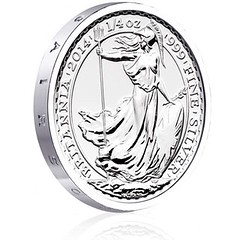
To read the earlier E-Sylum article, see: ROYAL MINT RECEIVES SS GAIRSOPPA BULLION (www.coinbooks.org/esylum_v17n15a27.html)
Yet More Bald People on Coins
Fred Michaelson writes:
Here's another baldie: Edward VII.

To read the earlier E-Sylum article, see: NOTES FROM E-SYLUM READERS: MARCH 30, 2014 : Still More Bald People on Coins (www.coinbooks.org/esylum_v17n13a08.html)
The Sherlockian Numismatists Club
Regarding Greg Ruby's call to organize a club of numismatic
fans of the fictional detective Sherlock Holmes, Alan Luedeking
writes:
Count me in! I collect Sherlock Holmes medals. Here's one of my favorites.
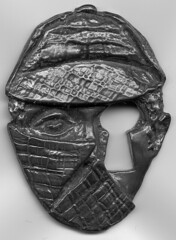
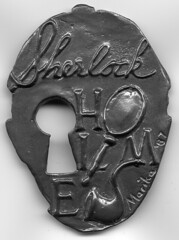
To read the earlier E-Sylum article, see: SHERLOCKIAN NUMISMATISTS CLUB PROPOSED (www.coinbooks.org/esylum_v17n15a15.html)
The Rare NGC Chocolate Slab
Dave Lange of Numismatic Guaranty Corporation writes:
Regarding the subject of chocolate coins, I have a brief recollection to share. When I first joined NGC in 1994 and started working its booth at shows, among the souvenir items we dispensed were replicas of the NGC slab with a Franklin Half Dollar enclosed, the entire unit made of chocolate and covered in gold-colored foil. I don't know how long these had been on hand, but I did venture to open and taste one of them. It was then I determined that they probably dated almost back to the company's 1987 founding, as the chocolate had nearly turned to stone. I believe we tossed the remainder a year or so later, and I've never seen one since. How's that for a rarity to entice the slab collectors?
To read the earlier E-Sylum article, see: MORE ON CHOCOLATE COINS (www.coinbooks.org/esylum_v17n15a18.html)
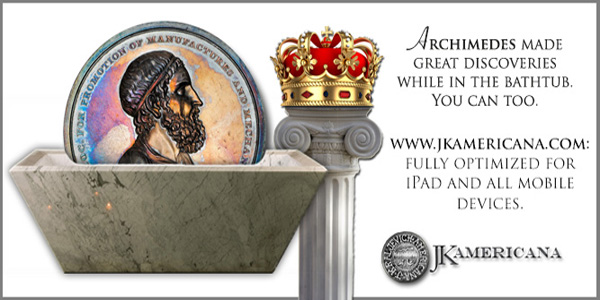
2014 MEMPHIS PAPER MONEY SHOW SPEAKERS
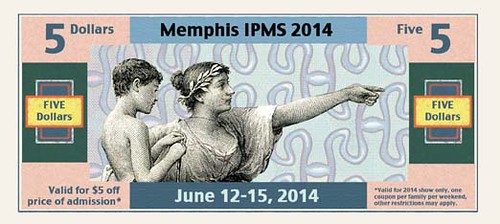
The Fakes Outnumber the Originals
Joseph Boling
Scarce world notes began to appear on internet sales sites a few years ago in quantities far in excess of pieces reported from collections. Learn how to distinguish the frauds such as German notes overprinted for use in Persia during WWI, Central Bank of China notes overprinted for Tibetan-speaking regions in the 1930s, French West Africa notes overstamped for Fezzan in WWII, People's Republic of China specimen notes of the 1980s-90s, etc.
The latest discoveries from the Eastern European Ghettos of
World War II
Ray and Steve Feller
Spectacular new discoveries from the World War II ghettos of Eastern Europe are lavishly illustrated and placed in context. Highlights include but certainly are not limited to a contemporary 2 mark counterfeit and error coin from Lodz ghetto, new paper finds from Theresienstadt, previously unreported scrip from the Warsaw ghetto, etc!
Before there were Stars
Shawn Hewitt
This is an in-depth look at the production of type note replacements at the BEP before star notes were introduced in 1910. Many of these non-star replacement notes can be distinguished. All are rare, so learn how to spot them.
Replacement notes from around the World
Ali Mehilba
The author of the newest and most definitive catalog of replacement and star notes produced by nations from across the globe will show you how to recognize and evaluate them. Replacement notes are substitutes for misprints caught during the manufacturing process in order to maintain counts.
Money of the People
Neil and Joel Shafer
Witness some of the most compelling and historically significant tales of how everyday people were forced to create their own paper money in order to survive. Fabulous illustrations.
Currency of French Indochina as influenced by World War
II
Roger Urce and Howard Daniel
French Indochina was comprised of present day Cambodia, Laos and Viet Nam prior to World War II. The war brought not only geopolitical upheaval, but fiscal restructuring as well. The many and varied currency issues of the era will be placed into the historic context of the war.
Enemy at the Gates - Civil War Scrip Issuers of New Orleans
1861-1862
Wendall Wolka
This is a fascinating story about the efforts of the City of New Orleans to redeem scrip issues from over 125 concerns in the city immediately after the city was captured by Union naval forces in late April, 1862.
To read the complete speaker list, see: Memphis Speaker Schedule - 2014 (www.memphisipms.com/MemphisTalks2014.pdf)
To learn more about the 2014 IPMS, see: www.memphisipms.com
MAJOR PRINCE AND THE 1859-S ONE DOLLAR GOLD PIECES
Major Prince and the 1859 S San Francisco Branch Mint one
dollar gold pieces
Dan Owens
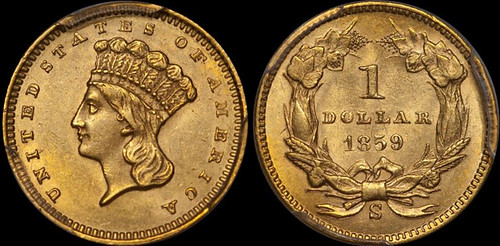
Spring had finally arrived after a hard winter, and with it a renewed sense of optimism.
The hourglass that marked the seasons had finally turned and grains of gold would begin their annual march to the Branch Mint.
 In April of 1859, surrounded by an
avalanche of double eagles, 15,000 one dollar gold pieces were
struck at the San Francisco Branch Mint. They were the only gold
dollar coins produced at the Branch Mint since June of 1858.
During the time period these pieces were struck, Major Henry
Prince, paymaster for the Utah Army, was in San Francisco from
Camp Floyd via Placerville to get U.S. Government drafts
cashed.
In April of 1859, surrounded by an
avalanche of double eagles, 15,000 one dollar gold pieces were
struck at the San Francisco Branch Mint. They were the only gold
dollar coins produced at the Branch Mint since June of 1858.
During the time period these pieces were struck, Major Henry
Prince, paymaster for the Utah Army, was in San Francisco from
Camp Floyd via Placerville to get U.S. Government drafts
cashed.
The San Francisco Bulletin on April 19th, stated that Prince had received the greater part of the amount of $150,000 coined in the Mint here in one dollar gold pieces.
However, the Branch Mint had only struck 74,232 one dollar gold coins in total, for the years 1854-1859. Instead, I think a more accurate statement would be that he received nearly $15,000 in one dollar gold coins as part of the Army's payroll. Thus I believe that a significant number of the surviving examples of 1859 S gold dollars were a part of Prince's 1859 Utah Army payroll.
The destination of the payroll was Camp Floyd located at Fairfield, Utah Territory. The newspapers wrote about the scarcity of money that had been severely felt during the winter months, not only by the Army but by the sutlers, merchants and dealers in general, who had been looking with anxiety for the return of Major Prince from California.
The Deseret News took exception to the news item published in the Bulletin, stating that the local folks had been led to believe that no inconsiderable amount of the "hard stuff" would be shortly put in circulation after the return of the Paymaster. The writer went on to sarcastically comment that the golden dreams of the money seekers will not be realized to any extent this time. In addition, the amount and type of money (one dollar gold pieces) obtained by Prince could have been brought through by any private gentleman without exciting the suspicions of a fellow traveler that he had more than the necessary pocket money along with him.
The writer concluded by asking if the Bulletin actually thinks that $150,000 would pay off the troops in the Department of Utah, when a number with one more zero on the right would be better suited to get the job done.
Regardless, on April 20th, Prince had left San Francisco Bay on the steamer Senator bound south for the port of San Pedro. He would then travel overland by way of Los Angeles and San Bernardino to the Utah Territory.
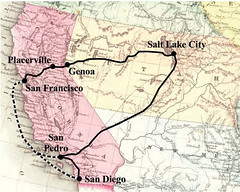
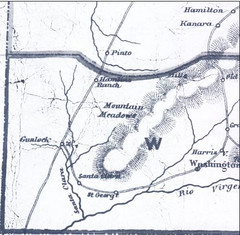
On April 21st, General Johnston, in command of soldiers in the thousands at Camp Floyd, gave Captain Reuben P. Campbell 2nd Dragoons, orders to travel as far south as Santa Clara in Southern Utah with one company of Dragoons and two of infantry. His mission was to protect travelers on the southern route in the spring from possible Indian threats and to escort Prince in his quest to deliver the payroll to Camp Floyd.
An eyewitness to a review of Johnson's forces at the Camp noted that the Dragoons on horseback in full dress and the batteries of Artillery, put on an unequaled display of splendor and effect.
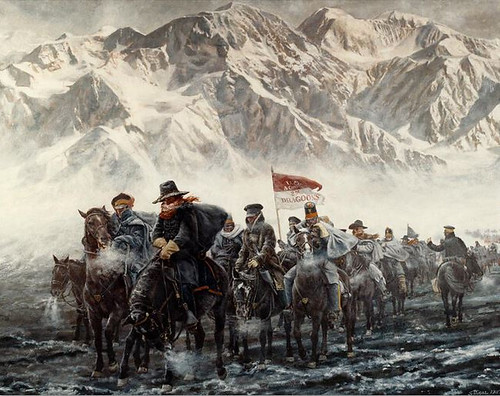
Meanwhile, the Los Angeles press noted that on April 24th, Major Prince took out $147,000, to pay the army and attaches in Utah. Brevet Major James H. Carleton, Company K, 1st Dragoons, would command the escort, alongside him was Lieut. C.H. Ogle. The armed escort had arrived from Fort Tejon north of Los Angeles. A Los Angeles based correspondent believed that Prince was really carrying half a million dollars.
On April 26th, the U.S. Army payroll was rolling through the Cajon Pass. The entourage consisted of half a dozen wagons, with mule teams; an ambulance, and a few travelers, who were well known to the soldiers. An insider wrote: "Thus far, the road, country, weather, grass, water and wood, have made our march a pleasure trip."
Major Prince and his escort exchanged wagons at the Muddy (a river approximately 60 miles north of present day Las Vegas), with Major Paul who had left Provo on April 21st. It was noted that, Major Carleton, Lieut. Ogle and men were all well, and progressing comfortably. The Indians along the road were peaceable.
During the month of May, Major Carleton via Prince's treasure convoy had met up with Captain Campbell's forces at the Santa Clara River in Utah before heading up to Mountain Meadows. In a detailed report published in 1859, entitled Special Report on the Mountain Meadows Massacre, Carleton stated he left Los Angeles on the 23rd of April, not the 24th alluded to earlier in the Los Angeles press, along with specific orders from General Clarke of the California Department to bury the bones of the Mountain Meadows massacre victims.
In September of 1857, a wagon train of Arkansas emigrants had been massacred primarily at the hands of a band of Mormons disguised as Indians. Upon Carleton's arrival at Mountain Meadows on May 16th, Campbell came up with his men from their encampment at the Santa Clara. Both parties would now make camp at the site.
On his way down from Camp Floyd, Campbell's command had already stopped at Mountain Meadows and under the skillful eyes of Assistant Surgeon Dr. Brewer United States Army, buried a number of human remains that were plainly visible and scattered about the grounds. A grim reminder of a dark page in the history of the West.
On May 20th, Carleton lead a party of men and made a more thorough search for human remains particularly amongst the sage brush and had them interred in a common grave marked by a stone cairn made of loose granite with a cross on top. Both Paymaster Prince, Dr. Brewer and others would help Carleton sift through the evidence for his report.
On June 1st, Prince arrived at Camp Floyd under the escort of Captain Campbell. To quote a local source: "All the gamblers, etc. have gone there, and we may soon expect to record a rush of business and plenty of the needful..." Prince, and Carleton went on to serve honorably for the Union in the Civil War. Campbell resigned from the United States Army and joined the Confederacy out of his native state of North Carolina. He died leading a charge of his men at the first battle of Cold Harbor in 1862.
According to United States gold coin expert Doug Winter, the 1859 S one dollar gold piece is undervalued in Uncirculated. Winter states: There are probably around 15 or so known (which makes it comparable to the much better- known and more highly valued 1859 D) with nearly all in MS 60 to MS 61. In MS 62, the 1859 S is quite rare and he has never seen an example that graded higher than MS 63. He believes the 1859 S is one of the more undervalued issues in the entire gold dollar series.
A MODERN "GOOD FOR" TOKEN FROM SHEPHERDSTOWN, WV
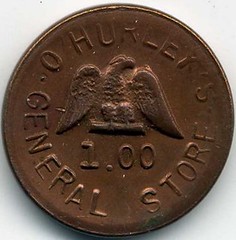
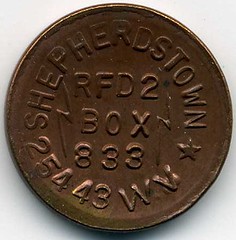
One of the benefits of collecting exonumia from my region is the ability to get to the source of the matter, so to speak. One such opportunity was recently afforded to me thanks to Dave Schenkman. At the February Nummis Nova dinner, Dave gave me a token of recent manufacture from O'Hurley's General Store in Shepherdstown, WV. The token, good for 1.00, was in a style that did not resemble anything from a major token maker but rather looked locally produced.

Seeing as I work near Shepherdstown, on a lunch break, I drove over to O’Hurley’s General Store to see if I could uncover the story behind the token. Sure enough, I talked to the owner of the store, Jay Hurley, who also happened to be the gentleman who made the tokens. When I first asked about them, he asked if I came to spend it. Considering my interest in tokens and how they were used, this provided me a rare chance to have such a discussion with a token maker as well as issuer.
The story he told me is that about 15 or so years ago, he and a local blacksmith had some scrap brass leftover from a recent metalworking job. They commented to each other that the metal looked very close to gold and that they should make some "gold coins" of their own.
The blacksmith cut the dies by hand and they modified a steel press/punch to strike the tokens. He said they struck one batch of about a hundred tokens. Hurley still has the dies but they were buried in a cabinet in the back and couldn't get to them easily when I visited.
The tokens were good for 1.00 and Hurley used to hand them out every once in a while. Such stories about similar tokens from the past are now lost forever, so I particularly value the chance to record these tales.
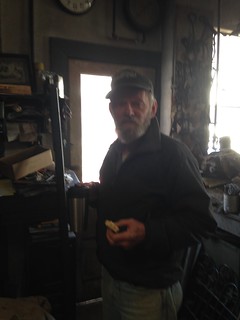
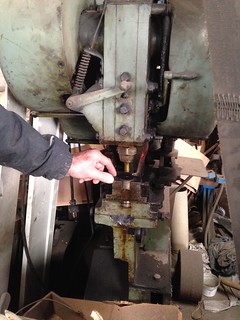
Jay Hurley and his coin press
THE BOOK BAZARRE
HARVEY STACK ON NUMISMATIC PEDIGREES
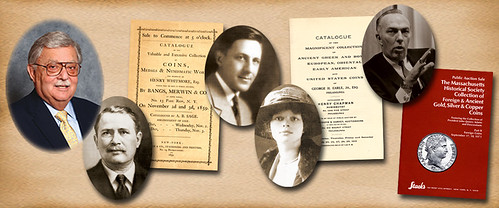
One of the many questions I am asked is: "Why is having the pedigree of rare coins and currency you sell important?" The pedigrees of numismatic items, works of art, jewelry, or other collectibles are valuable assets. They can record ownership from the day an item was issued or first sold and contain a history of subsequent owners. Most old-time collectors retained pedigrees, as they have been important to buyers through the decades. They are still important, right up to the present day, and the retention of pedigrees into the future will continue to add value to a numismatic item.
Collections in America, as well as the rest of the world, were mostly assembled by those who could afford to put items away and save them for the future. When we examine the early days of America and into the Industrial Revolution, collectors had many handicaps that do not exist today.
There was little if anything published that collectors could refer to, and they were lucky to have access to any information on coinage and coinage history.
Dealers of course experienced the same restrictions. Dealerships were located only in a few major cities or near them, auctions were few, and price lists were originally handwritten to the client, or in rare cases distributed to only a few. After the Civil War, some things changed. People earned a bit more, more wealth was accumulated, and important dealers in numismatics opened shops in Philadelphia, New York and Boston. These shops attracted mostly local collectors.
Auction sales became more prevalent and a few lists of coins were distributed. Many of these publications listed the famous collectors who had these coins for sale, and often previous owners were listed in the catalogs. The dealers felt that showing a pedigree established the worthiness of the coin, especially if the previous collector was known to be well educated in the fields he collected. A pedigree to an astute collector could show how a coin rated.
Before the late 20th century there were no grading services or encasement in sealed plastic holders. Today when a coin is graded it often has, if available, the latest pedigree of the coin printed on the holder. Years back when we did not have encapsulation of coins in "slabs" (the common word to describe the encased coins today), the owner of a coin often relied on the pedigree printed or written on a coin envelope (usually 2 x 2 inches), and that envelope was kept with the coin as it traveled from one collection to another. Earlier or when envelopes were not available, the owner or cataloger might try to match the coin to one in an earlier catalog, if it had a photograph or a distinct mark or impairment that could be described and readily identified.
Though these methods were not foolproof, for many coins they helped answer important questions: Who owed this coin before? Was he or she a famous person? Was this from some earlier, almost complete collection? Collectors became excited about a coin’s pedigree as well as its rarity, price and other features. The coin’s history became important and dealers, when describing a coin for auction or a price list, would research earlier pedigrees.
Dealers like Stack's Bowers research all coins they can for earlier pedigrees. The lots sold by auction usually have an envelope or tag identifying the sale they are being sold in, along with their lot number, so the pedigree is sustained for the future. In this way the value of a coin’s past can be maintained, as long as the information is kept intact.
To read the complete articles, see:
The Value of a Pedigree, Part 1
(www.stacksbowers.com/NewsMedia/Blogs/TabId/780/ArtMID/
2678/ArticleID/64437/The-Value-of-a-Pedigree-Part-1.aspx)
The Value of a Pedigree, Part 2
(www.stacksbowers.com/NewsMedia/Blogs/TabId/780/ArtMID/
2678/ArticleID/64455/The-Value-of-a-Pedigree-Part-2.aspx)
MORE ON HUGO GRECO
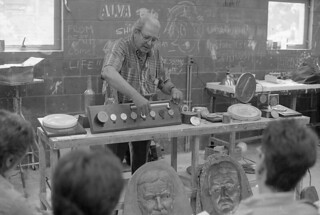
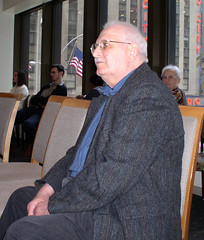
A Teensy Spelling Mishap
Fred Michaelson adds:
Wayne, do you think that Hugo Greco was really with a troupe of flamingo dancers?
To read the earlier E-Sylum articles, see:
HUGO
GRECO 1932-2014 (www.coinbooks.org/esylum_v17n15a05.html)
DICK
JOHNSON'S TRIBUTE TO HUGO GRECO
(www.coinbooks.org/esylum_v17n15a06.html)
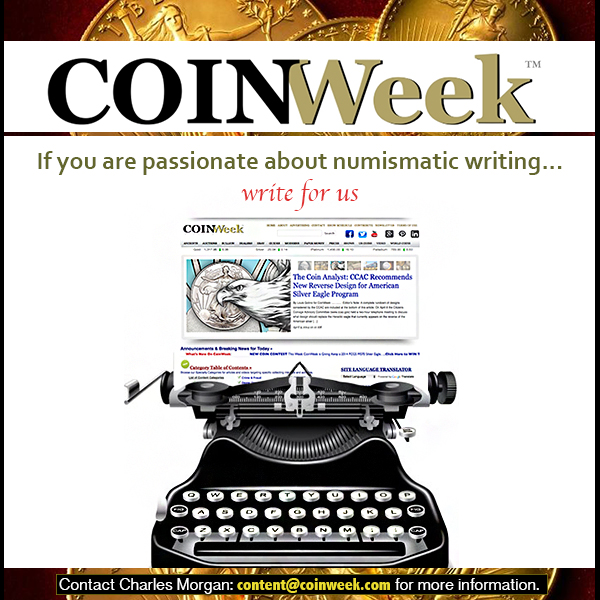
ASSISTANCE SOUGHT FOR 2ND EDITION OF VIRGINIA TOKENS
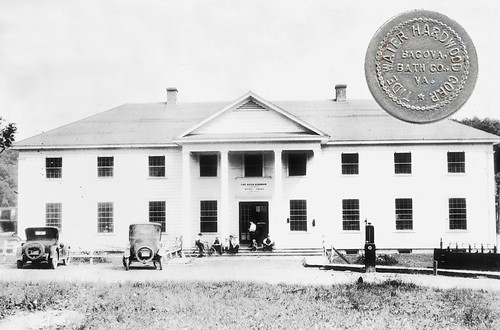
Bacova Tide Water Hardwood Corp. Commisary
The long-awaited second edition of David E. Schenkman's seminal catalog Virginia Tokens is in the works and your help is needed. Since its publication in 1980, many new token discoveries have been made and the new edition hopes to catalog as many confirmed pieces as is possible.
The current plan is for the new edition to be available by the 2015 VNA Convention & Coin Show. You can submit your tokens to Dave Schenkman at dave@turtlehillbanjo.com or to Eric Schena at eschena@hotmail.com. Please provide a clear photo or scan if possible. Be sure to include:
- Shape
- Diameter
- Composition
- Exact obverse and reverse inscriptions
- For mavericks, please include how the token was attributed.
In addition, a table will be set up to collect information on tokens currently not listed in the 1980 edition at the 56th Annual Virginia Numismatic Association Convention & Coin Show to be held September 25-28, 2014 at the Fredericksburg Expo & Conference Center.
Help contribute to the Commonwealth's token history - submit your unlisted tokens!
THOUGHTS ON THE 1933 DOUBLE EAGLE CASE
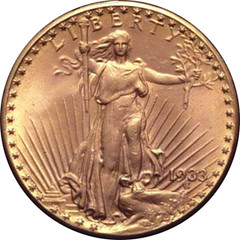 I am so glad the post in last
Sunday's E-Sylum prompted me to read David Tripp's
book again. It was a thoroughly amazing second reading,
refreshing my memory of this amazing tale. I will never forget
going to the LA office of Sotheby's with other PCGS graders
and giving our pre-grade to the coin in a room surrounded by
Secret Service agents (or Mint police or whatever they were), who
never took their eyes off the coin. They were replaced every
twenty minutes by others. I believe there were nine of them
guarding the coin in shifts.
I am so glad the post in last
Sunday's E-Sylum prompted me to read David Tripp's
book again. It was a thoroughly amazing second reading,
refreshing my memory of this amazing tale. I will never forget
going to the LA office of Sotheby's with other PCGS graders
and giving our pre-grade to the coin in a room surrounded by
Secret Service agents (or Mint police or whatever they were), who
never took their eyes off the coin. They were replaced every
twenty minutes by others. I believe there were nine of them
guarding the coin in shifts.
There has been so much speculation and misinformation about the coin sold in 2002. Here is my take:
If anyone has read David Tripp's book (Illegal Tender), they would know that the 1933 double eagles almost certainly were "converted" by the Mint Cashier George McCann in 1936 (swapped $500 in gold for the 25 1933 coins). Pretty good evidence. They all were sold into the market by a single source, Israel Switt, who sold the first ones to James Macallister, others to Ira Reed and Abe Kosoff, and possibly other dealers/collectors.
McCann was never convicted of this, because of the statute of limitations had expired, but did serve a year and a day in jail (convicted in 1941) for theft of worn coins brought to the Mint for exchange, while he was Cashier. Switt never revealed from whom he bought the coins, but it was almost certainly McCann. McCann lost most of his money in the stock market in 1938.
Only the two chattel pieces in the Smithsonian (not issued, so not coins) do not have questionable provenance, while the one sold in 2002 is the only one with legal tender status. This is why the government won the case against the Switt heirs and have possession of the ten coins. Those who believe these coins may have been obtained in 1933 should read David's excellent book. I believe they will change their minds.
Also, the main reason that the government settled with Steve Fenton was the 1944 export license issued for the Farouk coin (they split the proceeds in the sale in 2002 for over 7.5 million). The government felt that a jury might think the 1944 export license might sway them and they would lose the case.
Also, John Kraljevich and I became totally convinced in Steve's London shop that the coin sold at the 2002 auction was the Farouk coin. Steve showed us other coins that came with the 1933 and they were from the Farouk sale. We both left his shop totally convinced that the 1933 double eagle was the Farouk coin.
The story Fenton was told by the seller (a Cairo jeweler) was that an Egyptian Colonel had obtained them in the Farouk sale. Another story the author heard (not in the Tripp book) was that Farouk's physician was given these coins in payment for his services, as the new government would not pay him. Neither of these may be accurate, but the coins sold to Fenton all matched the 1954 catalog, including at least one unique pattern that could have come from no other source! Several other patterns were plated in the catalog and the coins bought matched the photographs.
The money received by McCann was deposited in his account in 1936. Switt and his brother-in-law partner, Edward Silver, had withdrawn $1,000 on ten occasions from January 9, 1936 to June 1, 1936. George McCann had unexplained income of $9,837.50 for 1936 and would not answer as to the source of the income in 1940, during the investigation of the theft of the worn coins, as noted earlier. McCann went to jail for a year and a day for these thefts.
McCann's first deposit was February 25, 1936 and his last was June 2, 1936. The money was not just for the 25 1933 double eagles, but also for 1931 and 1932 examples, as Switt sold these two dates in quantity to several dealers. McCann could not be prosecuted, as noted, as the statute of limitations had expired. Some 1933 eagles may also have been included in the sales.
David Tripp’s research was used by the government in the Switt trial and the outcome in favor government was the result of overwhelming evidence that Switt obtained the coins from McCann. As Cashier, McCann was really the only one who had unfettered access to the coins. The money deposited in his account led the investigators to the only logical conclusion: George McCann did it.
Fred Michaelson adds:
I think that many people would agree that the #1 mint theft was the recent Double Eagle fiasco, but it was the Feds that stole them from the Switts.
To read the earlier E-Sylum article, see: MORE MINT ROBBERIES (www.coinbooks.org/esylum_v17n15a20.html)
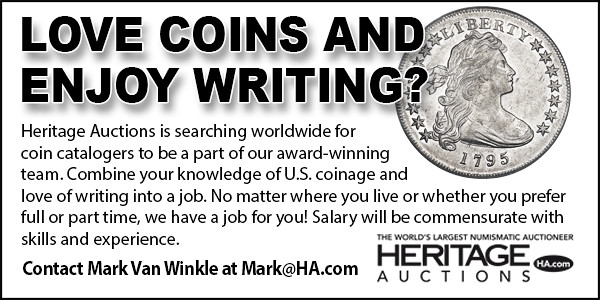
WAYNE'S NUMISMATIC DIARY: APRIL 13, 2014
On the afternoon of Tuesday April 8 I became aware that David Lisot's video interview with me at the March Baltimore coin show had been published. I watched it before leaving my office, and forwarded it to members of Nummis Nova, my northern Virginia numismatic social group. I would be meeting them for dinner in an hour or so.
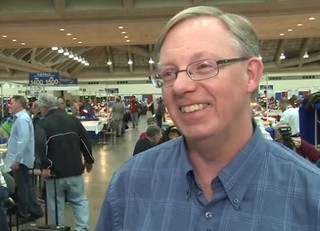 Roger Burdette responded
quickly, joking "Who was the handsome guy being
interviewed?" I was very pleased with how it turned out.
David asked me about The E-Sylum and how it came about. At
the dinner that evening Chris Neuzil told me he'd learned a
number of things from the interview. As the one who lived through
it all I guess I do take certain things for granted. Have a look
yourselves at the link below. Thanks, David!
Roger Burdette responded
quickly, joking "Who was the handsome guy being
interviewed?" I was very pleased with how it turned out.
David asked me about The E-Sylum and how it came about. At
the dinner that evening Chris Neuzil told me he'd learned a
number of things from the interview. As the one who lived through
it all I guess I do take certain things for granted. Have a look
yourselves at the link below. Thanks, David!
To view the E-Sylum video interview, see: Editor Wayne Homren Talks About E-Sylum Numismatic Electronic Publication. VIDEO: 3:36 (www.coinweek.com/video-news/new-videos/editor-wayne-homren-talks-e-sylum-numismatic-electronic-publication-video-336/)
I arrived at Legal Sea Foods in the Tyson's Galleria about 6:30 and soon found everyone in a private room in the back of the restaurant. Our host was Eric Schena. Regulars Tom Kays and Julian Leidman were unable to attend, but already present were Eric, Chris, Roger, Aaron Packard, Mike Packard (no relation), Gene Brandenburg, Ron Abler, Wayne Herndon, Jon Radel, Joe Levine, Steve Bishop, and Dave Schenkman.
I grabbed an empty seat to the right of Jon, and soon Lenny Goldberg filled in the seat to my right. Across from us were Eric and Joe. Holding court at the far end of the table was Roger. I passed around a few items of numismatic ephemera that I'd picked up recently. Other show-n-tell items for the evening included a slabbed 1795 dollar.
I got up and visited folks at other parts of the table before and after dinner, chatting with Wayne, Dave, Eric and others. Gene was his usual generous self, offering me a glass from his bottles of wine, which I eagerly accepted. I took the red, my usual, even though Gene had properly schooled me last month in what a good white wine tastes like (very good!).
Aaron had emailed me previously about some interesting Civil War-era cardboard scrip notes, and he showed me the images on his tablet computer. Aaron wrote:
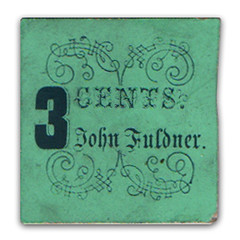 I picked up several pieces
recently, and was only able to attribute them via Ezekiel's
article in The Numismatist 1912, pg. 218.
I picked up several pieces
recently, and was only able to attribute them via Ezekiel's
article in The Numismatist 1912, pg. 218.
Coincidentally, while looking around to see if any catalogs exist, I came across an archived article from The E-Sylum, Volume 9, Number 26, June 25, 2006, Article 11, entitled "CIVIL WAR CARDBOARD SCRIP." It looks like you were the author and you were also aware of Ezekiel's 1912 write-up.
Aside from the scant list in Rulau's token book, as per your E-Sylum article, is there indeed no catalog for Civil War Cardboard scrip? The pieces that I picked up possess provenance from a Bowers & Merena sale that occurred in 1985.
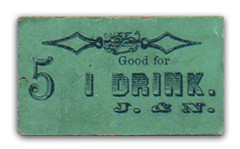

I was sorry to say I wasn't aware of any such catalog. Fred Reed's recent book on U.S. Civil War Stamp Envelopes is a close cousin (and another collecting favorite of mine), but there's a big gap for cardboard scrip. Some is covered under various state obsolete currency books, but other than some scattered articles, there is no book on the subject.
To read the earlier E-Sylum article, see: CIVIL WAR CARDBOARD SCRIP (www.coinbooks.org/esylum_v09n26a11.html)
Jon Radel had some recent catalogs of world telephone tokens on display, He also had a nice pair of medals, recent purchases from eBay. They were French Civil Service medals for the PTT (Postes et Télécommunications).
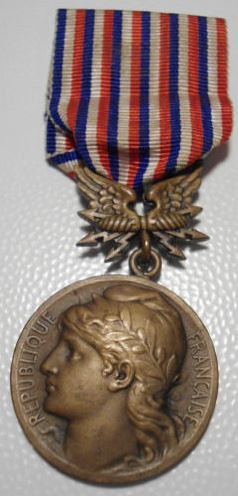

For more information, Jon recommends thie Wikipedia entry: Médaille d'honneur des PTT (fr.wikipedia.org/wiki/M%C3%A9daille_d%27honneur_des_PTT)
To read the original eBay entries, see:
Médaille
d'honneur des postes et télégraphes bélière bicéphal bronze
1925 Dacier (www.ebay.com/itm/141014406186)
Médaille
d'honneur des postes et télégraphes en argent officier
(/www.ebay.com/itm/200942246611)
One of the discussion topics was my recent trip to Pittsburgh to work on numismatic literature from the John Burns estate. It's a huge chore. There was only time to do the most basic triage; as much as I would have loved to, organizing the books by subject just wasn't in the cards. But Pat McBride and his crew are still working on it, and we should be ready for the auction at the PAN show in May.
It was another great evening of numismatic fellowship. The next morning before heading to work I watched another of the videos David Lisot filmed at the March Baltimore show. He had interviewed me, Allen Berman, Charlie Davis, John Kraljevich and Del Parker about John Burns. The end result is a superb tribute to our old friend. Follow the link below to watch it on the CoinWeek site.
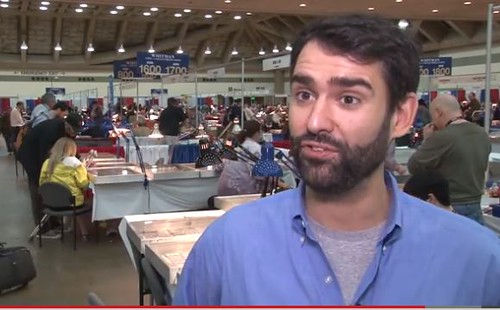
John Kraljevich discussing John Burns
To view the Burns remembrance video, see: Numismatic Book Dealer John Burns Remembered. VIDEO: 9:06 (www.coinweek.com/books-2/numismatic-book-dealer-john-burns-remembered-video-906/)
THE DIE THAT STRUCK BRITAIN’S FIRST COINS?
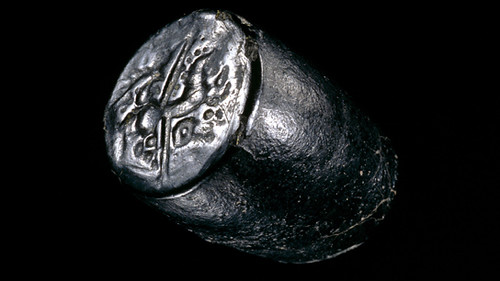
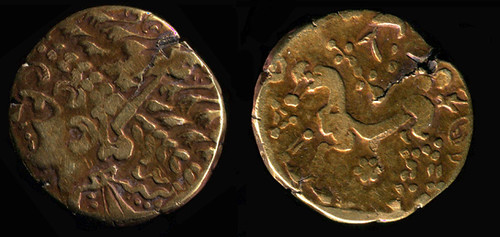
One of the most recent acquisitions made by the Department of Coins and Medals is a highly unusual object – an ancient punch or ‘die’ used to manufacture coins in the second century BC. The die was found in Bredgar, Kent by a metal detector user in 2013 and is being used to shed new light on when the first coins were made in Britain.
The earliest coins found in Iron Age Britain date from around the second century BC and, until recently, it was believed that they were produced in Gaul (a region roughly equivalent to modern day France and Belgium) and imported into south-east England. These coins, known as Gallo Belgic A, were based on the gold coinage (staters) issued by King Philip II, ruler of the Greek kingdom of Macedon from 359 – 336 BC and father of Alexander the Great.
Philip’s coin shows a representation of the god Apollo on one side and a chariot drawn by two horses on the other. Iron Age coins derived from these staters carry abstract versions of these images. The hair and laurel wreath on the image of Apollo, for example, are much exaggerated. Similarly, the image of the horse on the reverse of the coin has been stylised and is reminiscent of the Prehistoric chalk horses found on the hillsides of Britain, such as the one at Uffington.
Close examination of the coin die revealed that it was used in the production of the early Gallo-Belgic A coins. What this means is that, although it is the third Iron Age coin die to be found in the UK (the others are also in the British Museum), it is almost certainly the earliest. The most significant aspect of this discovery is the fact that it is a British find. This raises the intriguing possibility that the earliest known coins from Britain were actually made here and not just imports from the Continent.
Around 250 Gallo-Belgic A coins are known from Britain and France, but unfortunately the new die cannot be linked to any of them. This fact has been used to suggest that it may have been a forger’s die. In reality, however, we can read very little into the fact that we do not have an example of a coin struck using this die.
Little is known about the mechanics of coin production in the Iron Age and, in particular, about the authorities that produced them. The distinction between an ‘official’ and a ‘forger’s’ die may not be have been relevant in Iron Age society. A programme of scientific analysis will tell us more about how the die was made and used, but its precise origins are likely to remain a mystery. The die is on display in the Citi Money Gallery.
To read the complete article, see: The die that struck Britain’s first coins? (blog.britishmuseum.org/2014/04/11/the-die-that-struck-britains-first-coins/)
ALAN WEINBERG ON DAVIS FLIGHT MEDALS
I now own perhaps seven different specimens, most on Mexican 8 reales but two on Bust halves and one on a Seated Dollar (ex-Ford- JJF only owned one specimen). Several have "escaped" me - one in the American Numismatic Society and one sold last year by Heritage with a hanging badge suspension on a Seated Dollar (pictured in The E-Sylum), and of course, the one belonging to Nat Kaminski's family.
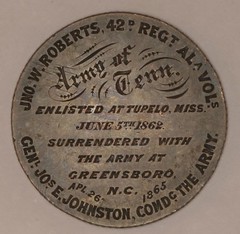 All of the specimens in my collection, all acquired individually
over many decades, were hand-engraved by the same skilled artisan
whom, it may be reasonably assumed, was camped outside of the
Greensboro surrender like a Sutler, and engraved departing
Confederate soldiers' take-home pay coins for a small
price.
All of the specimens in my collection, all acquired individually
over many decades, were hand-engraved by the same skilled artisan
whom, it may be reasonably assumed, was camped outside of the
Greensboro surrender like a Sutler, and engraved departing
Confederate soldiers' take-home pay coins for a small
price.
I emphatically disagree with Peter Bertram that the coins were engraved over a span of time years later, particularly since all mine and most others seen are all engraved by the same hand (easily discerned) and all very specifically dated down to the day - the 25 or 26th. Moreover, it is difficult to believe that the surrendered rag-tag Confederate soldiers who'd just been told to "go home" with their Mexican 8 real single coin payment from the remaining Confederate Treasury would have kept a Mexican unengraved silver coin in their possession for years later unless it had been specifically hand-engraved as a War memento at the time of Confederate surrender.
However, the Kaminski family specimen pictured in The E-Sylum which started this current conversation was engraved by another hand, in my opinion less skillfully engraved than the 1865 Greensboro pieces, and may have been done some time - perhaps years - later. It is evident that the reverse once had a brooch T-bar pin which was removed, solder remnants being clearly visible on both sides of the coin.
To read the earlier E-Sylum article, see: MORE ON ENGRAVED CONFEDERATE DAVIS FLIGHT MEDALS (www.coinbooks.org/esylum_v17n15a21.html)

THE COINS OF NEW YORK'S BRYANT PARK FOUNTAIN
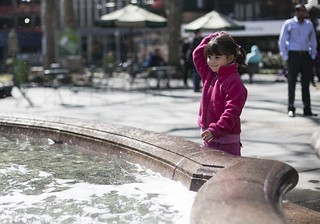 Every day countless stories, in the
form of coins, are deposited into Bryant Park’s pink granite
fountain in the heart of Manhattan. Some are wishes, some are a
personal mark, and others are a promise to return.
Every day countless stories, in the
form of coins, are deposited into Bryant Park’s pink granite
fountain in the heart of Manhattan. Some are wishes, some are a
personal mark, and others are a promise to return.
What happens to the coins after that is another story.
The fountain’s clear, bubbling waters are just blocks away from Times Square, and a favorite place for visitors and residents alike to throw coins. Nobody is counting the exact number, but they add up to roughly $3,000 to $4,000 a year.
Last year, coins from 76 countries, including the United States, were tossed in. Whether they’re then picked out by scavengers (as is common in the summer) or retrieved by the park staff, they become a living, breathing part of the city.
"I like throwing coins in the fountain and sometimes my wish comes true," said Soleil Skjorsammer, 7, during a recent sunny spring afternoon in the park with her mother and sister. "Before, my wish was I could be a good tennis player, and my mom told me I got better. This time, I wished I could play soccer."
The Bryant Park Corporation (BPC), which manages the park, has embraced the custom that transcends many cultures. From its offices across the street, the nonprofit entity has devised an intricate system to process the piles of coins it fishes out of the fountain each month when it undergoes cleaning and maintenance.
To say the least, it’s a complicated operation. But one that Jerome Barth, BPC’s vice president of business affairs, approaches with a smile.
"There’s no practical way to deal with it, so we just have fun," said Barth at the BPC office last week. "I think of it as a team building exercise."
 The "fun" includes
painstakingly sorting piles of grimy coins from a huge bucket
using a gold-mining pan in the office kitchen sink. The work of
donning pink rubber gloves to pick out rocks, debris, chewed gum,
and cigarette butts before the coins are washed with Dawn soap is
voluntary. Once washed, the coins dry in bowls on office
vents.
The "fun" includes
painstakingly sorting piles of grimy coins from a huge bucket
using a gold-mining pan in the office kitchen sink. The work of
donning pink rubber gloves to pick out rocks, debris, chewed gum,
and cigarette butts before the coins are washed with Dawn soap is
voluntary. Once washed, the coins dry in bowls on office
vents.
"It doesn’t smell like crisp, twenty dollar bills," said Barth.
Once in a while something truly rare and unusual turns up, a curious testament to the value people place on putting something in the fountain. At the BPC office, a 50 centimes 1936 silver coin from French Indochina is estimated to be worth about $50. Another unique find was a 1955 all-silver U.K. shilling.
The U.S. coins are deposited at TD Bank, because of its coin-counting machine. Though the BPC staffers admit they’ve accidentally broken the bank’s machine a few times with errant pieces of debris or dirty currency, they continue to go back.
Then there are the coins they can’t spend.
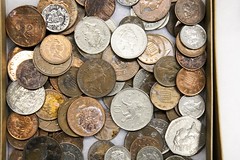 Whether from tourists or
foreign-born residents—it’s impossible to tell which—last year
park staff retrieved over 700 coins from 76 countries from the
fountain. Those unique coins are sent to the American Numismatic
Society (ANS) for study and research.
Whether from tourists or
foreign-born residents—it’s impossible to tell which—last year
park staff retrieved over 700 coins from 76 countries from the
fountain. Those unique coins are sent to the American Numismatic
Society (ANS) for study and research.
Among some of the more far-flung countries represented are Albania, Azerbaijan, Kazakhstan, Cuba, Zambia, Ghana, Iceland, Brunei, Aruba, and Vietnam. More commonly occurring pieces come from the eurozone (European countries using the euro), Australia, Japan, and Canada.
To read the complete article, see: If the Coins in Bryant Park’s Fountain Could Speak (www.theepochtimes.com/n3/607260-if-the-coins-in-bryant-parks-fountain-could-speak/)
NUMISMATIC VOCABULARY: TERMINUS POST QUEM
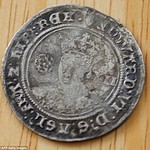 In December 2013 a metal detectorist
found an English coin from the 16th century on Canada’s West
Coast. A hobby archaeologist who heard about this took the find
to be proof of his theory that the English had discovered Canada
200 years before the Spanish. But does the coin really prove
that?
In December 2013 a metal detectorist
found an English coin from the 16th century on Canada’s West
Coast. A hobby archaeologist who heard about this took the find
to be proof of his theory that the English had discovered Canada
200 years before the Spanish. But does the coin really prove
that?
do you know what the technical term ‘terminus post quem’ means? My old prof of prehistory drilled this term into my brain. A terminus post quem is the moment after which something must have been buried in the earth.
I’ll give you a simple example. You go to your garden because you want to work it on this wonderful spring day. In your pocket you carry some change. Suppose you live in Switzerland. In that case you may have with you 50 rappen from 2007, 10 rappen from 1978 and even 20 rappen from 1896 – all coins which can still be found in circulation.
Let’s further suppose that in some 500 years an archaeologist will happen to find a little coin hoard composed of exactly these three coins because you will lose them in your garden today. And what will he deduce from the years of issue of these three coins? If he is smart – nothing. Only that the coins must have been dropped after the year 2007 – the terminus post quem.
The year of production does not tell us anything about the time when something was buried in the ground. And in order to stress this point, there is no need to refer to the well known Swiss collector who buried in his garden a small hoard of Sasanian coins just to make the life of future archaeologists a bit more thrilling.
Maybe the politician that argues for an English expedition to Canada should have attended lectures with my old prof.
To read the complete article Ursula was introducing, see: Can a coin rewrite Canada’s history? (www.coinsweekly.com/en/News/4?&id=2669)
The takeaway of all this, I think, is that the breathless reporting of a single find that overturns the entire known history of a region is to be taken with a grain of salt in much the same way we should avoid concluding that a single observation should completely overturn decades of established science. Of course, it is tempting for a journalist to report the bigger, slightly more sensational story...
To read the complete article, see: Shilling for Big History (skepticalhumanities.com/2014/03/11/shilling-for-big-history/)
To read the earlier E-Sylum article, see: EDWARD VI SHILLING FOUND VICTORIA, BRITISH COLUMBIA (www.coinbooks.org/esylum_v17n10a23.html)
BAVARIAN RAINBOW CUPS: RARE CELTIC GOLD STATERS
In the Alpine valley Etschtal, two major Celtic currency zones collided: Northern Italian restrikes of the silver drachms from Massilia (today: Marseille) and the so called Bavarian rainbow cups, ca. 7.5 g heavy gold staters.
According to popular belief, rainbows left a piece of gold - the rainbow cups - behind where they had touched the ground. Gold coins like this very often surfaced on fields after heavy rainfalls.
Similar circumstances also led to the discovery of three Celtic rainbow cups in Castello, near Brentonico (Rovereto), back in the year 1827.
The coins were acquired by Giovanni Battista Noriller (1789-1872), an attorney, who described and illustrated them in his book "I Lavini di Marco" (Rovereto, 1871).
In 1923, the Noriller collection and the Brentonico coins ended up in the collection of famous archaeologist Paolo Orsi and were then exhibited in the Museum in Rovereto.
The museum sold the coins in the 1920s in order to pay for the heating costs of the museum’s office rooms.
15 years ago, two of the Brentonico rainbow cups suddenly appeared on the Veronese coin market.
Unlike other Celtic gold coins, whose origin can with certainty be traced to Greek coins, the imagery on the rainbow cups from Southern Germany established a completely autonomous symbolic language. That is why scholars in the 17th century believed the coins had literally fallen from the sky or sprung from the earth.
This unfamiliar, abstract and often purely ornamental imagery was often considered primitive and barbaric up until the 19th century. Today, in a time where we are used to the style of artists like Klee, Picasso or Mirò, we can appreciate the imaginative design of some Celtic coins.
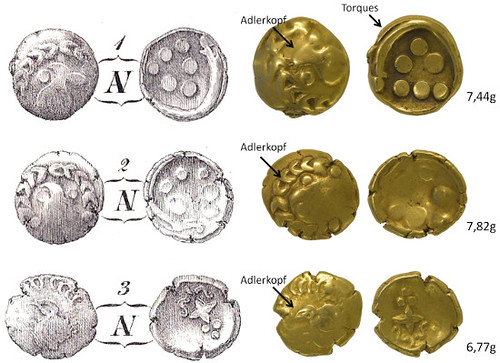
Comparison of Norill's drawings and the rediscovered originals.
All three gold coins from Brentonico, which with regard to their weight (6.77 g to 7.82 g) nominally correspond roughly to Greek staters, depict a convex bird head with a curved beak. Two of them further show a torc and six balls inside it on the concave side. These coins also feature a ball above and below the beak. The balls possibly indicate the coin’s value in analogy to the Republican Roman As, a bronze coin with a ship bow.
The depicted torc is a metal ring which was worn by Celtic, or more precisely by Gaulish, warriors as necklace and status symbol.
To read the complete article, see: Rediscovery of Celtic gold in Brentonico (www.coinsweekly.com/en/Rediscovery-of-Celtic-gold-in-Brentonico/8?&id=389&type=a)

BASEBALL COIN DESIGNER CASSIE MCFARLAND
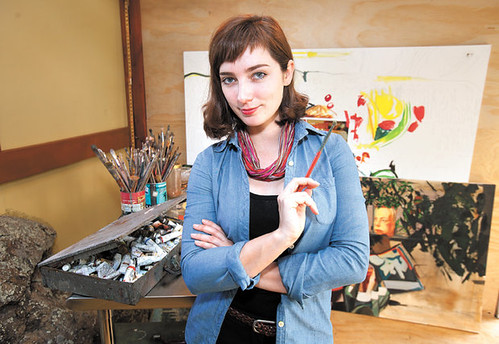
Coin collectors across the nation can now hold the work of San Luis Obispo artist Cassie McFarland in their hands.
More than a million coins bearing McFarland’s design went on sale March 27 as part of the U.S. Mint’s National Baseball Hall of Fame Commemorative Coin Program. The $5 gold coins, $1 silver coins and half-dollar clad coins, which depict a well-worn baseball glove on one side and a baseball on the other, are the first curved coins ever produced by the U.S. Mint.
"All in all, this is a great triumph for (me) as an artist," said McFarland, whose winning design edged out 15 other finalists. "It’s not every day that you design a gold coin that’s issued by the U.S. Mint."
McFarland, who grew up in Roseville, graduated from Cal Poly with a bachelor of fine arts degree concentrating in studio art and design. After living in Boston for two and a half years, she moved back to San Luis Obispo about three years ago.
McFarland, 28, said she stumbled upon the Baseball Hall of Fame coin design competition about a year ago, at a time when she was struggling to discover which artistic direction to take.
"What’s the best way to get your mind out of a creative box? To do something that’s different," McFarland said.
With just 24 hours to complete her submission, McFarland settled on a subtle yet effective design guaranteed to "evoke a little nostalgia on a national level," she said.
"I just wanted a simple design that everybody could relate to on a larger level," said the artist, who used a "completely broken-down" catcher’s mitt she found at her parents’ house as inspiration. "That glove is the perfect representation of childhood and camaraderie and being part of the team."
Although McFarland’s original design featured wheat sheaths — a tribute to her family’s involvement with the California State Grange, as well as old-fashioned "wheat pennies" that included images of wheat stalks — that detail was dropped from the finished product.
U.S. Mint sculptor-engraver Don Everhart sculpted McFarland’s design along with her initials, C.M. He also designed and sculpted the baseball — similar to the one used by major league players — on the reverse side.
Unfortunately, the official unveiling of McFarland’s design, originally planned for October, was delayed until March 27 because of the 2013 government shutdown. That didn’t stop the artist from visiting the U.S. Bureau of Engraving and Printing in Washington, D.C., then meeting U.S. Treasurer Rosie Rios and taking a sneak peek at the silver coin prototype.
Although she didn’t attend the March 27 unveiling, McFarland visited the San Francisco Mint on March 11, where she participated in a news conference, met with mint workers and signed baseballs.
McFarland, who was paid $5,000 for her design, said the experience has reshaped her view of the art world. She’s even bought one of the gold coins bearing her design, which she plans to store in a safety deposit box.
"Obviously I’m very elated," said McFarland, whose glove will be joining the Baseball Hall of Fame collection. "This is just a huge opportunity for me."
To read the complete article, see: SLO artist creates design for U.S. Mint's first curved coins (www.sanluisobispo.com/2014/04/07/3009270/slo-artist-baseball-curved-coins.html?sp=/99/177/183/)
SILVER EAGLE REVERSE DESIGNS DISCUSSED
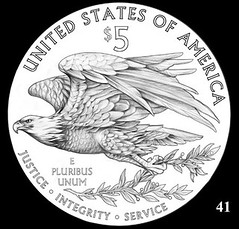 During a
teleconference meeting held on April 8th, 2014, the Citizens
Coinage Advisory Committee reviewed and discussed 44 possible
reverse designs for the American Silver Eagle bullion and proof
coins, pulled together from other programs. In attendance were
Chairman Gary Marks, Dr. Michael Bugeja, Robert Hoge, Erik
Jansen, Mike Moran, Michael Olson, Donald Scarinci, Jeanne
Stevens-Sollman, Thomas Uram, and Heidi Wastweet, as well as
members of the U.S. Mint staff and members of the press.
During a
teleconference meeting held on April 8th, 2014, the Citizens
Coinage Advisory Committee reviewed and discussed 44 possible
reverse designs for the American Silver Eagle bullion and proof
coins, pulled together from other programs. In attendance were
Chairman Gary Marks, Dr. Michael Bugeja, Robert Hoge, Erik
Jansen, Mike Moran, Michael Olson, Donald Scarinci, Jeanne
Stevens-Sollman, Thomas Uram, and Heidi Wastweet, as well as
members of the U.S. Mint staff and members of the press.
Dr. Michael Bugeja started the design comments with a retrospective of eagles and their use in coins in general, and in these designs in particular. He noted there are four types of eagles: stylized, personified, symbolic, and natural; in his opinion, only the symbolic type was appropriate for use on coins. Six of the members had indicated a preference for design 40, and eight had preferred design 41.
Michael Olson started his comments with a reminder that this coin is a flagship for the country. He would prefer more emphasis on the eagle over the shield. He was not inclined to reuse older designs. He indicated he would give his full support to design 41. He floated the idea of a redesign of the American Gold Eagle, much like the committee was currently discussing the American Silver Eagle. Chairman Marks replied that it was a possibility, just not being discussed at this time.
Heidi Wastweet noted she would want to see variations on design 41, giving the Mint artists some "breathing room". She also wanted to see arrows added to the existing olive branch, following the classic combination of peace with the threat to protect that peace. She said that she would want the American Silver Eagle "to be distinct" from any other coins (design 40 is currently up for approval by the Treasury Secretary for the 2015 US Marshals Commemorative $5 Gold Coin).
Donald Scarinci was wide-ranging in his comments. He gave an honorable mention to design 4, noting that the circular pattern invokes motion. He thought design 15 was "nice", but while he noted there were issues with the wings, he said it had "beautiful, clean fields" and a focus on the eagle over the other features. He said the eagle on design 22 was "gorgeous", noting it embraces the coin. He did not like design 40 for this coin in general, but also thought there was "too much happening." He closed his comments with a plea: "Can we just have an eagle?"
Erik Jansen indicated his preference to "action over pose", and encouraged his colleagues to vote for a series of preferences, rather than a single design. He said he would be "really really really let down" if the new design resulted in the "bird-feather equivalent of spaghetti hair". He asked the Mint to "sculpt detail, and not Photoshop this sculpt." He made a point of stating he was not in favor of design 41, noting the unrealistic depiction of the olive branch in the wind. His backup was design 24, but wanted to make sure it showed feathers and not scales. He also called out design 19 as an "interesting design," depicting two eagles over one. He liked design 44, but felt it wasn’t the right design for this coin.
Thomas Uram was the last to comment, and started with asking, "What is the upside of changing an already-successful design?" He was leaning strongly towards only changing the proof coin rather than it and the bullion coin. He mentioned that the 30th anniversary of the coin is coming up in 2016: a natural time to make a change, perhaps in a high relief specimen. He was not sure he was on the "design 41 train". His top pick was design 22, but it needs "LIBERTY" removed and the eagle strengthened. He closed his comments with a warning not to mess with "the best bullion coin that’s out in the world."
To read the complete article, see: CCAC Discusses Potential Silver Eagle Reverse Designs (news.coinupdate.com/ccac-discusses-potential-silver-eagle-reverse-designs-3231/)
SOME RECENT COIN DESIGNS: APRIL 13, 2014
Turkey's Bimetallic Animal Series
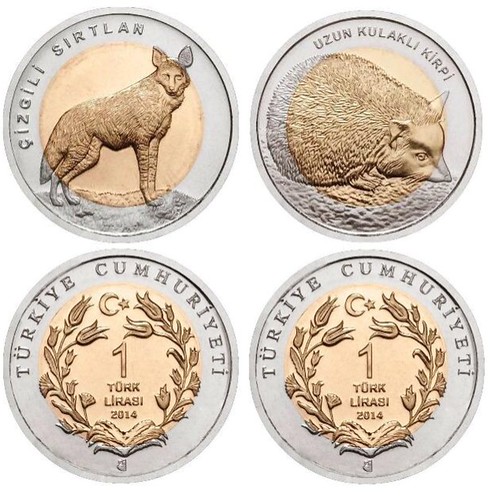
Centenary of Grytviken Church
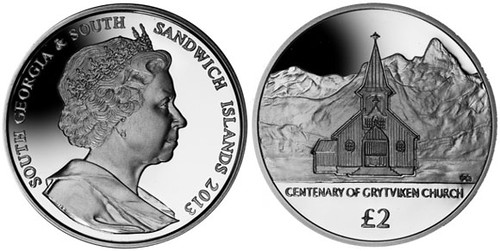
Romania Olympic Committee Coin
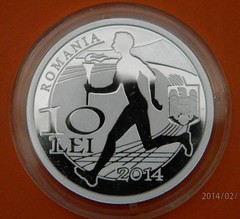

Poland 25 years of Freedom
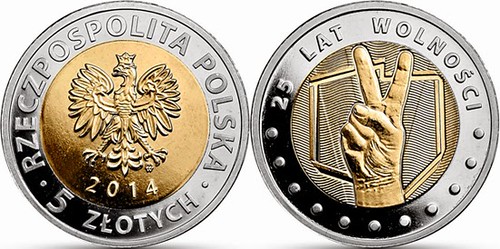
MORTON & EDEN TO SELL RARE RUSSIAN COINS
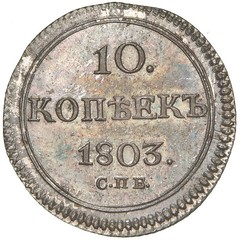 A group of rare silver Tsarist
coins in extraordinary condition has been discovered among a
large cache of otherwise mainly unremarkable coinage by
specialist London auctioneers Morton & Eden. The 39 coins, struck
during the reign of Alexander I, could raise as much as £100,000
when they are offered for sale on June 10.
A group of rare silver Tsarist
coins in extraordinary condition has been discovered among a
large cache of otherwise mainly unremarkable coinage by
specialist London auctioneers Morton & Eden. The 39 coins, struck
during the reign of Alexander I, could raise as much as £100,000
when they are offered for sale on June 10.
They were found by Jeremy Cheek when he was sifting through hundreds of small old envelopes of coins sent for appraisal by a descendant of an eastern European family whose members had emigrated to the West many years ago.
Most was worn common coinage of low commercial value, but one envelope contained what appears to be part of a set of silver kopecks of different dates and face values struck by Tsar Alexander I who ruled as Emperor of Russia from 1801 until his death in 1825. The coins are small, ranging from 14mm to 22mm (0.55-0.87 inches) in diameter.
"I was really surprised to find them in an otherwise fairly ordinary group of coins," Mr Cheek said, "and moreover I was astonished by their condition. Clearly they have never been in circulation. Their origin remains a mystery. Each coin is a different variety, there being no duplication, and yet there are no apparent records of such a set having been issued."
The group also includes coins with extremely rare dates. A 10 kopecks of 1803 is the most valuable. It was graded at MS65 on the PCGS scale and is estimated at £15,000-20,000. A 5 kopecks of 1812 (MS64), is estimated at £8,000-12,000, and a 5 kopecks of 1825 (also MS64), is estimated at £6,000-8,000. The sale on June 10 will be held at Sotheby’s London saleroom.
To read the complete article, see: Rare Russian coins discovered by Morton & Eden, to be auctioned on June 10 (artdaily.com/news/69330/Rare-Russian-coins-discovered-by-Morton---Eden--to-be-auctioned-on-June-10#.U0ncC_mcJRQ)
THE BOOK BAZARRE
CONSERVATION OF THE BEAU STREET COIN HOARD
For those who have been following the progress of the conservation of the Beau Street Hoard on the blog, I am delighted to announce that all the coins – around 17,500 of them – have now been cleaned to required identification standards, that is, to the point where the legend and significant features are readable. Conservator Julia Tubman carried out the bulk of this work on the c.17,500 coins contained within the hoard.
Additional work has been carried out on a small number of these coins and conservation has also been carried out on c.400 coins that were initial finds from the outer edges of the hoard, before the hoard proper was unearthed. This last group of coins were in particularly poor condition and most required substantial chemical and manual cleaning. These coins were held in numbered paper envelopes, some of which corresponded to small find numbers allocated when the hoard was excavated.
The soil block that held the hoard has now been dismantled and returned to the archaeologists who carried out the initial excavation for final sifting and checking for palaeoenvironmental remains: that is, material that might provide further contextual information about the coin hoard.
At the time of Julia’s last post, she reported that one of the coin clusters (bag 4), had been scanned. As with the other coins in the hoard, the clustered corroded coins retained the positions that they would have held in the bag in which they had been deposited. In this instance the bag shape was particularly well preserved. The initial scan was carried out at the British Museum by Martin Cooper of the Conservation Technologies Unit, National Museums Liverpool (NML).
The scan data was used to create a 3D computer model, which was then 3D printed to make a replica of the coin bag using Selective Laser Sintering (SLS), a process that uses a laser to fuse particles of plastic or other material into the required three-dimensional form. A plaster cast was then made from the print and this was painted to resemble the original coin cluster, by conservators at NML.
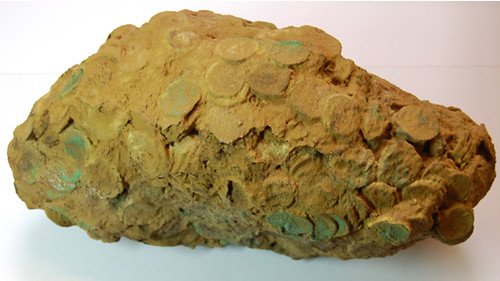
Beau Street hoard replica
The replica has proved very popular among visitors to the Roman Baths and was shown at a Beau Street Hoard community consultation event run by staff at the Roman Baths earlier in 2013. Members of Bath Ethnic Minority Senior Citizens Association (BEMSCA) were among those who handled the replica. As a three-dimensional record of the original form of the coin bag, which of course no longer exists now that the coins have been conserved, the replica is an excellent supplement to the information gathered about the hoard, an invaluable means of allowing people to gain some sense of the physicality of (at least part) of the hoard.
To read the complete article, see: The Beau Street Hoard: Not quite the end… conservation, outreach and further investigations (blog.britishmuseum.org/2014/04/08/the-beau-street-hoard-not-quite-the-end-conservation-outreach-and-further-investigations/)
HARVARD BOOK NOT BOUND IN HUMAN SKIN AFTER ALL

A centuries-old book long thought to be bound in human skin actually isn’t, researchers at Harvard University said.
Scientist Daniel Kirby determined the book’s cover is made from sheepskin, debunking a myth that’s piqued students’ interest for years.
"I think everyone had their doubts all along," said Kirby, who used a method called mass peptide fingerprinting to reach his conclusion.
He also determined the book’s glue is made from cattle and pig collagen. The 17th century book is part of the Harvard Law School’s library. The legend’s origin can be blamed on an inscription on the last page of the book, written
"The bynding of this booke is all that remains of my dear friende Jonas Wright, who was flayed alive by the Wavuma on the Fourth Day of August, 1632," it reads, according to a blog post on Harvard’s website. "King Mbesa did give me the book, it being one of poore Jonas chiefe possessions, together with ample of his skin to bynd it. Requiescat in pace."
But Kirby’s results don’t mean the book was never bound in human skin. "It’s a possibility that it had been recovered before it came into the collection," he said.
To read the complete article, see: Harvard Law Book Isn’t Bound In Human Skin After All (abcnews.go.com/blogs/headlines/2014/04/harvard-law-book-isnt-bound-in-human-skin-after-all/)
To read the earlier E-Sylum article, see: CREEPY HUMAN-SKIN BOUND BOOK OFFERED (www.coinbooks.org/esylum_v10n49a29.html)
PAUL BOSCO ON MANHOLE COVERS AND NUMISMATICS
I think I can say, without much fear of contradiction, that I am the champion of "weird stuff" in numismatics. However, even I would not include manhole covers, round and metallic as they are, as part of numismatics.
This does not justify a cavalier and patronising attitude toward these useful objects, such as was exhibited in the April 6 issue.
My friend Wolfgang Dressel, a conceptual artist from Berlin, proprietor of the gallery Kuprac, collected photographs of manhole covers in the early 1970s. Like high denomination Yap Island Stone money, it is impractical to collect the actual objects, so one collects the documentation,
In the mid-'70s I read a magazine article about manhole covers, I think in London streets. Penny Lane, perhaps. The article described what song melodies could be played by pinging successive covers, while perambulating particular paths. With the possible exception of Moby Dick and a Numismatist article on flush toilets, it was the most interesting thing I've ever read.
Latterly, my friend Wolfgang has been shown to have been a visionary. There is a Wikipedia entry for manhole covers, and hundreds of photographs of them on Google Images. A book, Manhole Covers, by Mimi Melnick, features an introduction by a distinguished critic/theorist/photographer, Cal Arts professor Allan Sekula (1951-2013). He writes: "Manhole covers are the secret cousins of coins..."
I have little idea what he means, although I may track down the book and read the rest of that sentence. My point is, it's not always safe to assume something is ridiculous.
THAT SAID:
On the subject of grading manhole covers on a 70-point scale, the great surface area both justifies and cries for this degree of precision --far more so than their dimunitive numismatic "cousins". Now, how one takes into account the reverses, which, presumably, are never to be seen, is probably a question for philosophers, like chickens, eggs, and falling trees in forests. One nice aspect of manhole-cover-grading is that nothing should be body-bagged for "environmental damage".
The municipality with the #1 Registry Set would inarguably deserve to host the ANA Convention. As long as it's not "Chicago".
To read the earlier E-Sylum article, see: THE E-SYLUM 2014 APRIL FOOL'S ISSUE: SPECIAL ANNOUNCEMENT FROM WHITMAN PUBLISHING, LLC. (www.coinbooks.org/esylum_v17n15a17.html)
FEATURED WEB PAGE: ENGLISH BANKING HISTORY
This week's Featured Web Page is the British Museum's introduction to English banking history.The origins of English banking can be found in the activities of the London goldsmith-bankers during the period 1650 to 1700. London goldsmith-bankers initiated and developed the basic principles of accepting deposits on which interest was paid, made loans from the funds supplied by such deposits, issued their own promissory notes (or banknotes) and allowed depositors to access their accounts by use of ‘drawn notes’ (or cheques).
The note illustrated here is an example of an early drawn note or cheque. This example is dated 9 October 1725 and is addressed to Abraham Fowler, Goldsmith, who was a goldsmith-banker at the ‘Sign of the Three Squirrels…Fleet Street’.
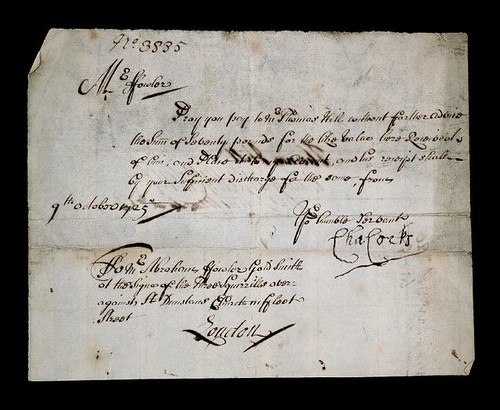
www.britishmuseum.org/research/publications/
online_research_catalogues/paper_money/
paper_money_of_england__wales/english_banking
_history.aspx
